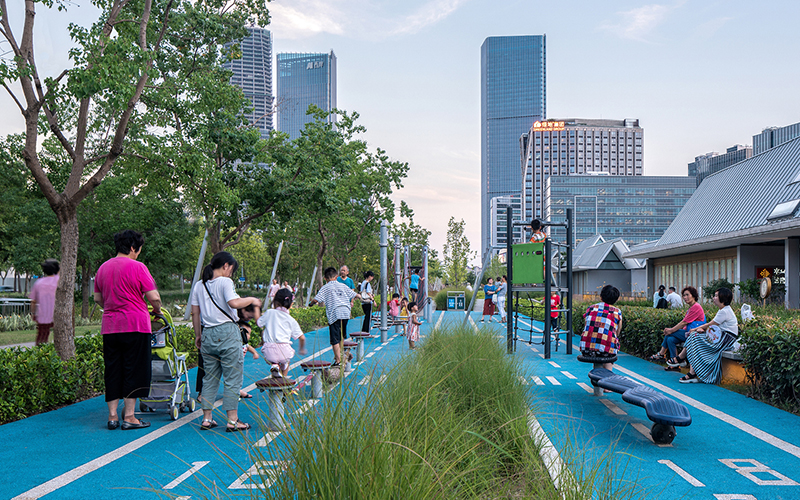Landscape Architects Unite in Advance of Key United Nations Climate Change Conference
 ASLA 2021 Professional Urban Design Honor Award. Xuhui Runway Park, Shanghai, China. Sasaki. / Insaw Photography
ASLA 2021 Professional Urban Design Honor Award. Xuhui Runway Park, Shanghai, China. Sasaki. / Insaw PhotographyThe American Society of Landscape Architects (ASLA) announced today it will join a global coalition of 70,000 landscape architects in 77 countries in committing to limiting planetary warming to 1.5°C (2.7 °F). This is the largest coalition of landscape architecture professionals ever assembled to advance climate action.
IFLA’s Climate Action Commitment will be issued to sovereign nations at the United Nations Framework Convention on Climate Change (UNFCCC)’s 26th Conference of the Parties (COP26), which will be held in Scotland, October 31 - November 12.
ASLA has committed to the six goals outlined in the IFLA Climate Action Commitment:
1) Advancing the United Nations Sustainable Development Goals (UN SDGs)
ASLA and its member landscape architects and designers will accelerate efforts to protect and repair ecosystems.
2) Attaining Global Net Zero Emissions by 2040
ASLA and its members will dramatically reduce operational and embodied carbon emissions produced by projects, increasingly harness the unique capacity of landscapes to draw down carbon dioxide, and continue to advocate for low-carbon multi-modal transport systems.
3) Enhancing Capacity and Resilience of Livable Cities and Communities
Implementing green infrastructure approaches, ASLA and its members will increase efforts to mitigate the urban heat island effect and reduce climate impacts associated with fire, drought, and flooding.
4) Advocating for Climate Justice and Social Well-Being
ASLA and its members will maintain our priority on equity and equality and ensure the right to nearby green spaces and clean water and air.
5) Learning from Cultural Knowledge Systems
ASLA and its members commit to respecting and working with indigenous communities and honoring cultural land management practices to mitigate climate change impacts and continue work towards reconciliation.
6) Galvanizing Climate Leadership
Landscape architects are uniquely positioned to lead the built environment community’s response to the climate crisis. ASLA will continue to collaborate with clients, suppliers, and allied professions to champion climate positive landscapes, which involves planning and designing landscapes that sequester more greenhouse gas emissions than they emit.
“ASLA is proud to be joining forces with IFLA and the global community of landscape architects in advancing our climate action goals,” said Torey Carter-Conneen, CEO, ASLA. “We speak as one voice, globally, when it comes to advancing climate action.”
“As landscape architects we can make a tremendous difference to climate change and to climate action through our work, so thinking globally but acting locally is critical,” said IFLA President James Hayter.
“In a year marked by historic flooding in Europe and China and deadly wildfires and heat waves in the United States, it’s clear we’re running out of time to start healing a century’s worth of harm done to our Earth and its atmosphere,” said Tom Mroz, FASLA, ASLA President.
“I am gratified that Climate Positive Design has been incorporated into the global Commitment,” said Pamela Conrad, ASLA, Founder of Climate Positive Design, Principal at CMG Landscape Architecture in San Francisco, and IFLA Climate Change Working Group Vice Chair. “All landscape architects must rapidly scale up their work transforming designed landscapes into natural carbon sinks.”
The IFLA Climate Action Commitment is the second major coalition ASLA has joined this year. ASLA also signed on to Architecture 2030’s 1.5°C COP26 Communiqué, calling for built environment industries to achieve zero greenhouse gas emissions by 2040.
Landscape architects plan and design with nature to help all communities reduce greenhouse gas emissions and adapt to a changing climate. Landscape architects use climate positive design approaches that transform parks and open spaces into natural carbon sinks. They develop resilient nature-based solutions that reduce the impacts of extreme heat; coastal, ground, and inland flooding; sea level rise; pollution; and wildfires. They also increase biodiversity and protect and restore ecosystems, which underpin life on Earth.
“Landscape architects are already helping communities adapt to climate impacts. We are having a particularly big impact on reducing dangerous urban temperatures, saving many lives in the process,” said Vaughn Rinner, FASLA, former ASLA President and ASLA representative to the IFLA Climate Change Working Group.
About ASLA
Founded in 1899, the American Society of Landscape Architects (ASLA) is the professional association for landscape architects in the United States, representing more than 15,000 members. The Society’s mission is to advance landscape architecture through advocacy, communication, education, and fellowship.
About IFLA
A truly global federation, IFLA currently represents 77 national associations from Africa, the Americas, Europe, Asia Pacific, and the Middle East. Our mission as landscape architects is to create globally sustainable and balanced living environments for the benefit of humanity worldwide. IFLA officially represents the world body of landscape architects through its member associations and regions and in both governmental and non-governmental organizations, such as the UN, UNESCO, UIA, etc. We are a not-for-profit, non-political, non-governmental organization.